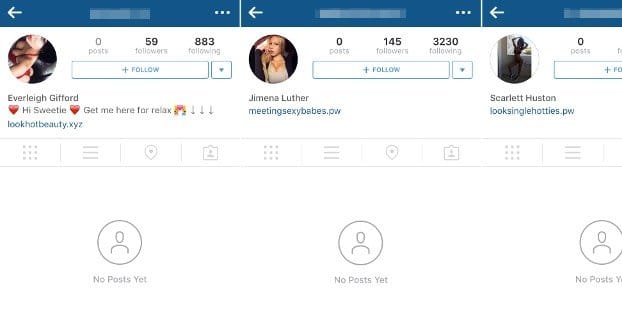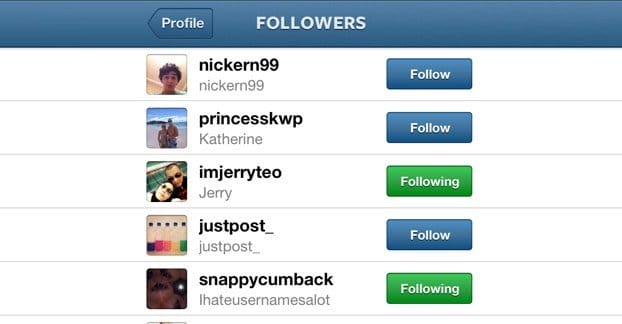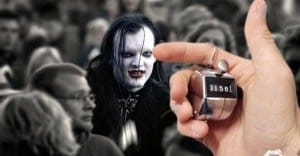 Written by ContentPowered.com
Written by ContentPowered.com
Fake followers are a problem on pretty much every platform. On Instagram, they tend to be a pretty big issue, for a few reasons. For one thing, they don’t help you. Fake followers clutter up your audience. That means you get bad information in your analytics, your posts are shown to people who aren’t real, and your engagement rates are low. On top of that, some fake followers might not just be inactive, idle bots. They could be spambots, looking to see who posts on your content, targeting them for spam.
Instagram is a great site for engagement if you can use it, but fake followers hurt that very benefit. Estimates indicate that as many as 8% of Instagram accounts are fake accounts, and as many as 30% of the rest are inactive.
Fake followers:
- Hurt your engagement rates directly, by not engaging on any of your content.
- Hurt your engagement rates indirectly, by not sharing your content.
- Weaken your brand reputation because they’re easy to expose.
- Can be removed at any moment in a purge.
- Can make your account a target for negative action, under the assumption that you purchased your fake followers.
- Never buy your products, go to your website, read your blog, or otherwise benefit you in any way.
So how can you identify fake followers, to remove them in a purge of your own?
Identifying Fake Followers Manually
The first thing you should look for are any “fan buying” accounts that follow you. Accounts like BUYFANS are spambots fishing for your business. They’ll follow you in hopes that you’ll see them and check out their website, go to buy their bot followers, and perpetuate their business. They’re scams, obviously enough.
There are other accounts that operate the same way but with a little more subtlety. They may have real names and pictures, but their bios and their posts still relate directly to the fan buying business. Remove those as well, block them, and report them if you want to do Instagram a favor.
Next, scan through and look for the accounts that have no profile picture. Some of these accounts may be real people who registered to follow you or to enter Instagram-based contests, but many of them are simply low effort bots. The way you tell the difference is typically in the number of accounts they follow. If the account has no profile picture and no posts, and they follow a dozen or so accounts, that’s probably fine. It’s an inactive account that isn’t necessarily hurting you, but it’s not really helping you either.
On the other hand, an account with no posts of its own, but hundreds or thousands of follows, is more likely to be a fake account. If you check, you’ll see that the accounts they follow have very little in common, and don’t really reflect the natural interests of a typical user.
Next, you should turn your attention to your own posts. No, I’m not accusing you of being a fake follower yourself, you don’t need to unfollow yourself. What you’re looking for are comments on your content. Comments will come in four categories.
- Good, insightful comments. These are great to have and should be encouraged. When you see them, respond to them and try to start conversations.
- Mediocre support comments. Comments like “great photo” and the like can fall into this category, as can comments in general support of your brand. They aren’t good for starting conversations but they work for filler.
- Nonsensical or boring comments. “Great photo” comments, “like” or “y” or other single-word comments, they can be relevant but they might also be spam engagement to make a bot look better. Investigate these accounts and see if they follow you, and if they do, determine if they’re fake accounts. Some will be real, which makes you wonder what kind of person leaves those sorts of comments, but nevermind that. Others will be fake accounts, and you can easily block them.
- Actual spam comments. Sometimes a bot will go around posting comments about how you can buy their account, or how you can buy more likes for your photos, and so forth. These are excellent targets for the block-report-remove combo.
While it can be painful to delete engagement of any sort, letting spam sit on your posts gives other people a bad impression. Some of them will ignore it or won’t care, but other people will recognize that spam comments mean spam followers, and they’ll start to wonder how many other followers you have happen to be fake. Fakes will drive off real followers who don’t think they’re getting the real story, so it’s a good idea to get rid of them even if it hurts.
Now, this manual overview of followers can take quite a while, particularly if you have a significant number of followers. However, it’s always a good idea to invest the time to protect your account. The longer you let it go, the more likely you are to have a bigger problem down the line. It’s like seeing termites in an old wooden house; the damage you can see may be minor, but there’s a lot more going on under the surface and it can lead to a catastrophic collapse somewhere down the line.
Once you have audited your followers, you should establish habits to protect yourself from future infestations. Essentially, you just want to monitor the people following you. Whenever you get a notification that a new user followed you, take a second to check out their page. Do they have posts and a profile picture? Do they have information filled out? Do they follow an extreme number of other users? Does anyone follow them? The worse an account looks, the more likely it is to be spam, and the safer you will be removing them. Sure, you’ll probably let the occasional good fake through, and you’ll block the occasional real account, but it all tends to balance out.
If you would like to do a more automated check, you can use a site like FollowerCheck. It’s a site that scans your followers looking for fakes, and delivers you a card with some basic information. It shows the raw number of real versus assumed fake followers, gives you a short list of what are the most suspicious followers, and formats it all in a nice embeddable box. You know, in case you want to advertise it.
Of course, this site isn’t necessarily that valuable. It can show you if it suspects you have a problem, but it’s only really accurate for accounts that have a few thousand followers at most. The reason is plain if you scroll down; they take a random sample of 150 accounts from your followers list and audits those. They check for profile completeness and they check for the follower:following ratio. It can net some false positives – and some false negatives – and with such a small sample size, it can end up giving wildly different results for checks on the same audience.
Unfortunately, most of the tools to check fake followers individually are designed for Twitter, which has better APIs for the process, or no longer exist. IGExorcist, for example, was a pretty good fake checker, but has since lapsed and no longer exists.
At the end of the day, you’ve probably found and removed a decent number of fake followers. They slip through the cracks pretty easily, so it’s always a good idea to do an audit, probably about once every six months. This will depress your growth, though, and while it will increase your engagement rates, it will decrease the number of followers and the raw number of comments you get, at least in the short term.
The solution, then, is to enact strategies to get more legitimate followers. You can always go out and pay for them via ads through Instagram or through third party sellers, but there are also plenty of organic growth tips you can use.
- Browse industry-related hashtags looking for users who post frequently in your industry. Start to network with these users by liking their content and leaving good comments of your own here and there. Ideally, they will take notice of you, see that you’re posting content in the same niche, and will respond in kind.
- Every few days, go through and like dozens or even hundreds of photos in your niche. Try to like them from a wide variety of different accounts, rather than all from one small subset of users. This notifies the owners of those photos, and will get them to check you out. Some of them will certainly follow you.
- Hold engagement-focused contests on Instagram. For example, you can post an interesting picture and ask people to caption it. This will get you a lot of engagement, as well as a lot of follows if you attach a prize to the contest. Just make sure people know they have to follow you to be eligible to win.
- Hold content-focused contests as well. Post an image of a topic and ask your users to submit their own images about that topic in response. Once again, attach a prize to the contest and make following a stipulation. You can hook even more people just by liking the submissions when you receive them.
- Focus on posting great content in favor of posting a lot of content. Think about three posts you could make every day, and post the best one of those three. Unless you have a volume-based gimmick – which you shouldn’t, as a marketer – you can dial back on your volume in favor of studying the content that gets the most engagement.
- Maintain consistency in both the quality of your posts and the frequency. Try to always post around the same times of day, though you can adjust this to match the peak active hours of your audience. You can measure this using Buffer or just by monitoring your users.
- Don’t be afraid to follow users, so long as they’re users in your niche. Relevant follows are always a good thing, and you can build your reputation as an influencer by spreading around that value. Just be cautious that you’re not following dramatically more people than follow you, and that you’re not following completely irrelevant accounts. Make sure they post content you like seeing before you follow them.
- Take advantage of geographic targeting. In general, targeting where you are when you take a photo can go a long way towards reaching that local audience. This doubles in importance when you’re out and about, either traveling abroad or attending a special event. Tagging the location for these can help you network with other people doing the same, and with people in those locations.
- Keep an eye out for influential Instagram users who may have used your products, or who have posted about using your products, and reach out to them. Ask them for an endorsement, a follow, or even just a comment on one of your pictures. You can return the favor and start up a mutually beneficial relationship between brand and influencer.
One technique to avoid, by the way, is using overly generic follow-centric hashtags. Using a f4f – follow for follow – tag will tend to result in a lot of low quality followers who will either stop following you shortly thereafter, or who will end up being spambots looking to boost their own metrics so they look more legitimate to those audits and scans from the first part of this post.
Regardless of the techniques you use, you should always be vigilant. Keep an eye out for whenever a new user follows you, and check to make sure they’re a real user. They might not be part of your niche, they might just be a personal user, and they might never be someone you would personally follow back, but as long as they’re real, they’re worth keeping around.
2018 Update
There are a few new products that just came out that can help you scan a profile to decide if it’s real or fake.
These are: Fakecheck.co, Social Audit Pro, and FakeLikes.info.
These are all paid apps, so they aren’t the best for casual Instagram users, but for businesses with thousands of followers, it may be a useful tool to audit and prune any bot followers on your profile.
Instagram has done a great job with their updates the past few years, so bots are becoming less and less prevalant, but if any squeak by, it’s good to immediately remove them.
Do you have any favorite tools that you use to remove bots and fake people from your Instagram profile? Let us know in the discussion below!





